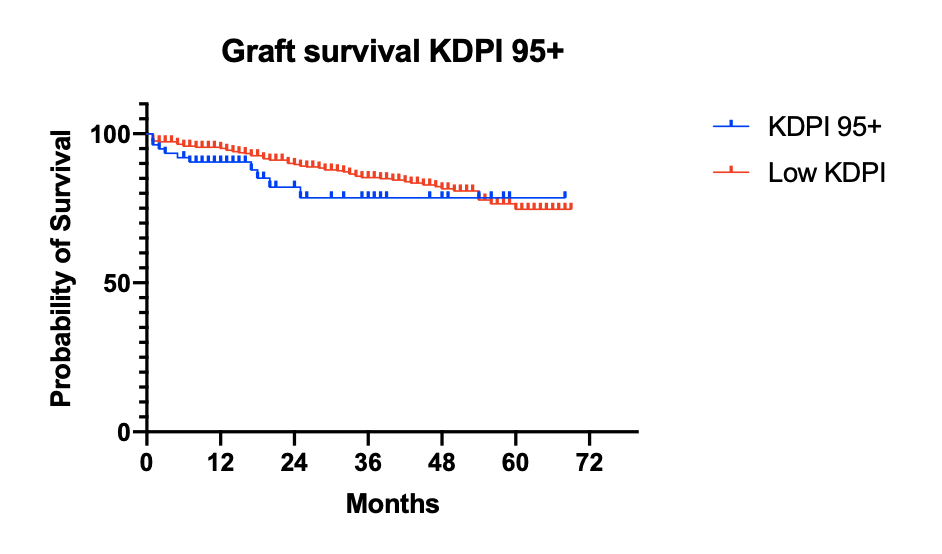The Extremes of KDPI: Even KDPI 95%+ Kidneys Can Be Used Successfully
Medstar Georgetown Transplant Institute, Washington, DC
Meeting: 2021 American Transplant Congress
Abstract number: 842
Keywords: Donors, marginal, Elderly patients, Kidney transplantation
Topic: Clinical Science » Kidney » Kidney Deceased Donor Selection
Session Information
Session Name: Kidney Deceased Donor Selection
Session Type: Poster Abstract
Session Date & Time: None. Available on demand.
Location: Virtual
*Purpose: While the use of kidneys with KDPIs greater than 85% has become common, there is still reluctance among centers to use the very highest KDPI kidneys (95%+) for fear of poor outcomes. In our center’s highly competitive region we have routinely used these kidneys and with the upcoming changes in the kidney allocation system, we expect this to increase. We reviewed our experience with these high KDPI kidneys to see if their outcomes warrant continued use.
*Methods: This is a single center retrospective study. We reviewed all patients receiving deceased donor kidney (DDK) transplants since KDPI was put into common use in December 2014. We looked at graft survival, death censored graft survival (DCGS), delayed graft function (DGF), extended DGF (greater than 10 days) and primary non-function (PNF) as outcomes measures. We also stratified transplants by the age of the recipient into 2 groups: those 61 years old or greater, and those 60 years old or younger. Data was analyzed using Fishers exact test with a 2-tailed p value.
*Results: We had a total of 753 solitary DDKs transplanted at our center. There were 80 kidneys that had a KDPI of 95% or greater. Average follow-up was 25.2 months although the high KDPI group did have overall shorter follow-up (mean 18.7 months, p=0.001). There was no difference between the groups in graft survival (figure 1, p=0.59) or DCGS (91.2% vs 90.2% p=1.0). The high KDPI group had somewhat higher but statistically similar rates of DGF (36.7% vs 30.2% p=0.055). When looking only at extended DGF the differences reached statistical significance (21.3% vs 11.1% p=0.017).
When stratified by recipient age, there were no statistically significant differences in graft survival, DCGS, DGF, or extended DGF either when comparing high KDPI vs low KDPI kidneys in elderly patients, or when comparing high KDPI kidneys in elderly vs younger patients (table 1).
*Conclusions: In an increasingly competitive environment, kidneys with KDPIs of 95%+ can provide excellent medium-term results for recipients of all ages similar to those seen with lower KDPI kidneys. These organs represent an increasingly valuable resource which will need to be used aggressively as we adapt to a new kidney allocation system that further encourages competition between centers.
| KDPI 95+, Age >60 | KDPI 95+, Age <60 | p value | KDPI <95, Age >60 | p value | ||
| Number | 39 | 41 | 185 | |||
| DGF | 51.3% | 31.7% | 0.11 | 34.6% | 0.07 | |
| Extended DGF | 28.2% | 14.6% | 0.81 | 14.6% | 0.58 | |
| Graft Survival | 87.2% | 85.4% | 0.80 | 89.7% | 0.58 | |
| DCGS | 97.4% | 85.4% | 0.11 | 92.4% | 0.48 |
To cite this abstract in AMA style:
Gilbert A, Verbesey J, Thomas B, Moore J, Cooper M. The Extremes of KDPI: Even KDPI 95%+ Kidneys Can Be Used Successfully [abstract]. Am J Transplant. 2021; 21 (suppl 3). https://atcmeetingabstracts.com/abstract/the-extremes-of-kdpi-even-kdpi-95-kidneys-can-be-used-successfully/. Accessed December 31, 2025.« Back to 2021 American Transplant Congress

